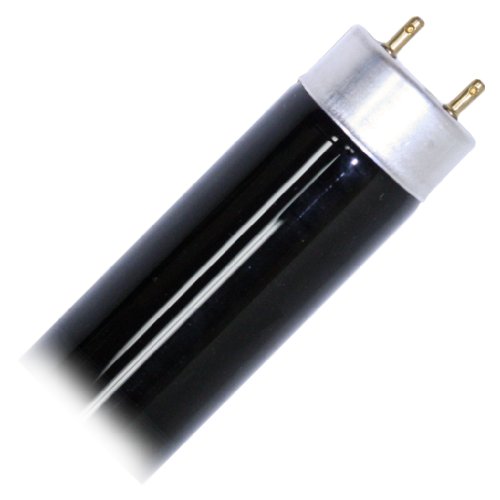

Once its lit it goes into this light purple that you characteristically see in bug zappers or bug attractants. And when this one is unlit it simply has a white phosphor appearance. We should state this isnt the kind of black light that is used for special effects like the black light blue, thats a completely different type of black light. Its very simple to look on the side of the light tube itself to see which one you have and select from our list. It comes in all different sizes which vary in watts and length of the light bulb and whatever fixture that you have needs to be matched up to that length and wattage. Nearly all of it's light comes from that area of the visible spectrum which can be used for many of the tasks that we have been talking about. The 350 stands for 350 nanometer peak in the spectral range. But most of these have been used for many decades in the past and still give the exact type of lighting you need in a narrow part of the spectrum. Typically these run off a magnetic ballast or possibly an electronic ballast if you have a newer unit. If you're looking for them in a bug zapper, then the size must be exactly the same as what you use now. There are many industrial machines that use this type of bulb to spot imperfections or used in some kinds of metal or plate exposure. Black light 350 bulbs are used mostly for special exposure and bug light fixtures. The "black" glass tube itself blocks most visible light, so in the end only benign long-wave UV-A light and some blue and violet visible light pass through.B元50 blacklight light bulbs used in certain exposure processes are known also as 350 black lights or 350BL. This coating absorbs harmful shortwave UV-B and UV-C light and emits UV-A light (in the same basic way the phosphor in a fluorescent lamp absorbs UV light and emits visible light). A tube black light is a basically a fluorescent lamp with a different sort of phosphor coating. There are actually two different types of black light, but they work in basically the same way. Black lights work on this same principle. In a fluorescent lamp, the emitted light is in the visible spectrum - the phosphor gives off white light we can see. This photon has less energy than the original photon, because some energy was lost as heat. When the electron falls back to its normal level, it releases energy in the form of another photon. When a photon hits a phosphor atom, one of the phosphor's electrons jumps to a higher energy level, causing the atom to vibrate and create heat. Phosphors are substances that give off light - or fluoresce - when they are exposed to light. They do this with a phosphor coating around the outside of the tube.


UV light waves are too short for us to see - they are completely invisible - so fluorescent lamps have to convert this energy into visible light. They emit some visible light photons, but mostly they emit photons in the ultraviolet (UV) wavelength range. When energized, mercury atoms emit energy in the form of light photons. Fluorescent blacklight lamps generate light by passing electricity through a tube filled with inert gas and a small amount of mercury. How a Black Light Works: The conventional black light design is just a fluorescent black light lamp with a couple of important modifications.


 0 kommentar(er)
0 kommentar(er)
